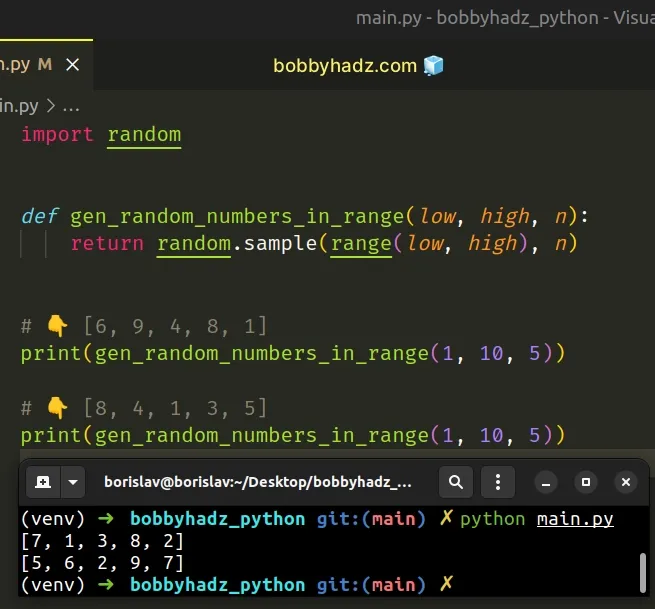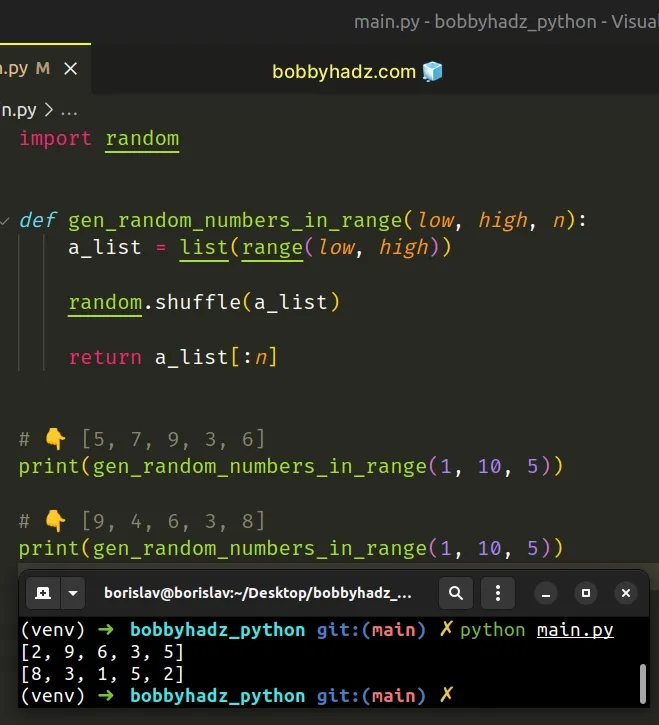Generate N unique Random numbers within a Range in Python
Last updated: Apr 10, 2024
Reading time·6 min

# Table of Contents
- Generate N unique random numbers within a range in Python
- Generate N unique random numbers within a range using random.shuffle()
- Create list of random numbers without duplicates using numpy
- Generate random number in range excluding some numbers
# Generate N unique random numbers within a range in Python
To generate N unique random numbers within a range:
- Use the
range()class to create arangeobject. - Use the
random.sample()method to get a list of N unique random numbers. - The
random.sample()method returns a list of N unique elements from the provided sequence.
import random def gen_random_numbers_in_range(low, high, n): return random.sample(range(low, high), n) # 👇️ [6, 9, 4, 8, 1] print(gen_random_numbers_in_range(1, 10, 5)) # 👇️ [8, 4, 1, 3, 5] print(gen_random_numbers_in_range(1, 10, 5))

We used the range() class to get a range object.
print(list(range(1, 5))) # 👉️ [1, 2, 3, 4] print(list(range(1, 8))) # 👉️ [1, 2, 3, 4, 5, 6, 7]
The range() class is commonly used for looping a specific number of times.
The range() class takes the following arguments:
| Name | Description |
|---|---|
start | An integer representing the start of the range (defaults to 0) |
stop | Go up to, but not including the provided integer |
step | Range will consist of every N numbers from start to stop (defaults to 1) |
The random.sample() method returns a list of N unique elements chosen from the provided sequence.
import random # 👇️ [5, 3, 8, 4, 7] print( random.sample( range(1, 10), 5 ) )
The random.sample() method returns an N-sized list of elements chosen from the
sequence without replacement.
The random.sample() method raises a ValueError if the sample is larger than
the sequence.
import random # ⛔️ ValueError print( random.sample( range(1, 5), 5 ) )
If you need to handle this scenario, use a try/except block.
import random try: random_numbers = random.sample( range(1, 5), 5 ) except ValueError: # 👇️ this runs print('The sample is larger than the sequence')
Trying to retrieve more elements than are present in the range caused a
ValueError which was then handled by the except block.
Alternatively, you can use the random.shuffle() method.
# Generate N unique random numbers within a range using random.shuffle()
This is a four-step process:
- Use the
range()class to get arangeobject. - Use the
list()class to convert therangeobject to a list. - Use the
random.shuffle()method to shuffle the list. - Use list slicing to get N unique random numbers from the list.
import random def gen_random_numbers_in_range(low, high, n): a_list = list(range(low, high)) random.shuffle(a_list) return a_list[:n] # 👇️ [5, 7, 9, 3, 6] print(gen_random_numbers_in_range(1, 10, 5)) # 👇️ [9, 4, 6, 3, 8] print(gen_random_numbers_in_range(1, 10, 5))

The random.shuffle() method takes a sequence and shuffles it in place.
import random a_list = list(range(1, 10)) random.shuffle(a_list) print(a_list) # 👉️ [4, 7, 3, 9, 1, 2, 8, 6, 5]
The last step is to use list slicing to select N unique random elements from the list.
The syntax for list slicing is my_list[start:stop:step].
The start index is inclusive and the stop index is exclusive (up to, but not
including).
start index is omitted, it is considered to be 0, if the stop index is omitted, the slice goes to the end of the list.Python indexes are zero-based, so the first item in a list has an index of 0,
and the last item has an index of -1 or len(my_list) - 1.
The slice list[:n] returns the first n elements of the shuffled list.
# Create list of random numbers without duplicates using NumPy
This is a three-step process:
- Use the
range()class to create arangeobject. - Use the
numpy.random.choice()method to create a list of numbers without duplicates. - Set the
replaceargument toFalseto select unique numbers.
import numpy as np list_of_numbers = np.random.choice( range(1, 15), 6, replace=False ).tolist() print(list_of_numbers) # 👉️ [13, 14, 9, 6, 11, 12]

Make sure you have the NumPy module installed to be able to run the code sample.
pip install numpy # 👇️ or with pip3 pip3 install numpy
The numpy.random.choice method generates a random sample from the given array-like object.
replace argument determines whether a value of the array-like object can be selected multiple times. The argument defaults to True.We set the replace argument to False, so no duplicates are selected.
You can use the tolist() method if you need to convert the NumPy array to a native Python list.
# Generate random number in range excluding some numbers
To generate a random number in a range, excluding some numbers:
- Use a list comprehension to iterate over a
rangeobject. - Use the
not inoperator to exclude the numbers from the list. - Use the
random.choice()method to generate a random number in the range.
from random import choice def gen_random_number(low, high, exclude): return choice( [number for number in range(low, high) if number not in exclude] ) numbers_to_exclude = [1, 3, 7] # 👇️ 2 print(gen_random_number(1, 10, numbers_to_exclude)) # 👇️ 19 print(gen_random_number(1, 100, numbers_to_exclude))
We used a
list comprehension to
iterate over a range object.
The range() class is commonly used for looping a specific number of times.
print(list(range(1, 5))) # 👉️ [1, 2, 3, 4] print(list(range(1, 3))) # 👉️ [1, 2]
On each iteration, we use the not in operator to exclude a list of numbers
from the result.
from random import choice def gen_random_number(low, high, exclude): return choice( [number for number in range(low, high) if number not in exclude] )
The in operator tests
for membership. For example, x in l evaluates to True if x is a member of
l, otherwise, it evaluates to False.
x not in l returns the negation of x in l.The last step is to use the random.choice() method.
The random.choice method takes a sequence and returns a random element from the non-empty sequence.
import random print(random.choice(['a', 'b'])) # 👉️ "a"
If the sequence is empty, the method raises an IndexError.
from random import choice def gen_random_number(low, high, exclude): return choice( [number for number in range(low, high) if number not in exclude] ) numbers_to_exclude = [1, 3, 7] result = [ gen_random_number(1, 10, numbers_to_exclude) for _ in range(3) ] print(result) # 👉️ [5, 2, 5]
We used a list comprehension to iterate over a range object of length N and
called the get_random_number() function on each iteration.
Alternatively, you can use set objects.
# Generate random number in range excluding some numbers using a set
This is a four-step process:
- Get a
setcontaining all numbers in the range. - Convert the list of numbers to exclude to a
setobject. - Get the difference between the
setobjects. - Use the
random.choice()method to generate a random number in the range.
from random import choice def gen_random_number(low, high, exclude): return choice( list( set(number for number in range(low, high)) - set(exclude) ) ) numbers_to_exclude = [1, 3, 7] print(gen_random_number(1, 10, numbers_to_exclude)) # 👉️ 4 result = [ gen_random_number(1, 10, numbers_to_exclude) for _ in range(3) ] print(result) # 👉️ [5, 2, 5]
We used the set() class
to convert the range object and the list of numbers to exclude to set
objects.
difference() method.The minus sign is a shorthand for calling the difference() method on the
set.
print({1, 2, 3} - {2, 3}) # 👉️ {1}
The
difference()
method returns a new set with elements in the set that are not in the
provided iterable.
We used the list() class to convert the
set object to a list and used the random.choice() method to pick a random
number from the list.
# Additional Resources
You can learn more about the related topics by checking out the following tutorials:

